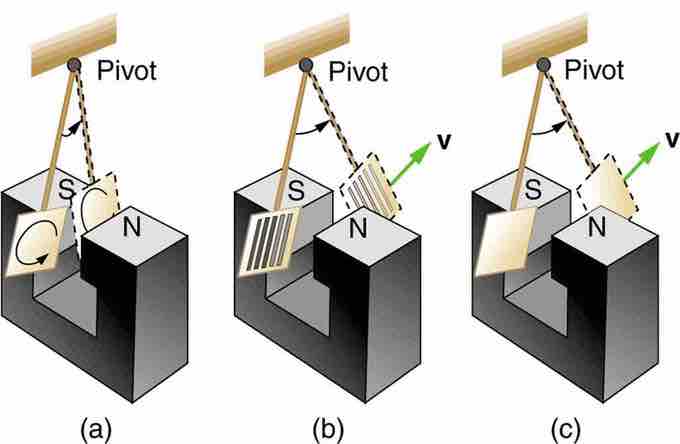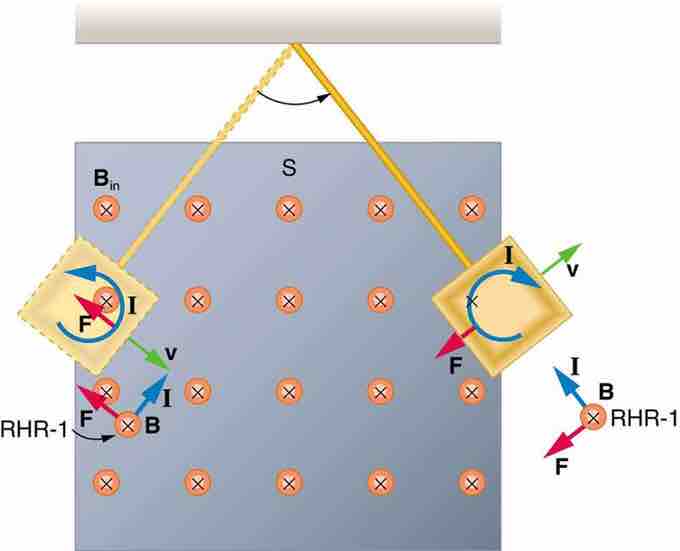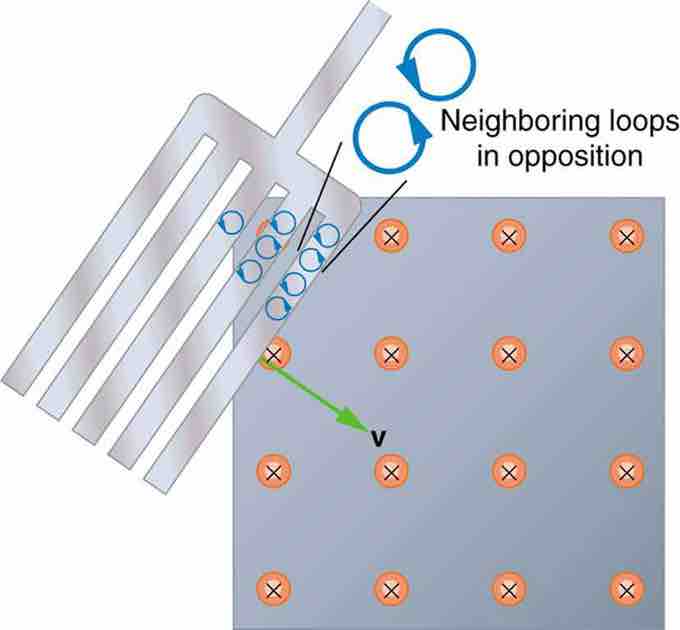Back EMF
Motors and generators are very similar. (Read our Atoms on "Electric Generators" and "Electric Motors. ") Generators convert mechanical energy into electrical energy, whereas motors convert electrical energy into mechanical energy. Furthermore, motors and generators have the same construction. When the coil of a motor is turned, magnetic flux changes, and an electromotive force (EMF), consistent with Faraday's law of induction, is induced. The motor thus acts as a generator whenever its coil rotates. This will happen whether the shaft is turned by an external input, like a belt drive, or by the action of the motor itself. That is, when a motor is doing work and its shaft is turning, an EMF is generated. Lenz' law tells us the induced EMF opposes any change, so that the input EMF that powers the motor will be opposed by the motor's self-generated EMF, called the back EMF of the motor.
Eddy Current
As discussed in "Motional EMF," motional EMF is induced when a conductor moves in a magnetic field or when a magnetic field moves relative to a conductor. If motional EMF can cause a current loop in the conductor, we refer to that current as an eddy current. Eddy currents can produce significant drag, called magnetic damping, on the motion involved.
Consider the apparatus shown in , which swings a pendulum bob between the poles of a strong magnet. If the bob is metal, there is significant drag on the bob as it enters and leaves the field, quickly damping the motion. If, however, the bob is a slotted metal plate, as shown in (b), there is a much smaller effect due to the magnet. There is no discernible effect on a bob made of an insulator.

Device for Exploring Eddy Currents and Magnetic Damping
A common physics demonstration device for exploring eddy currents and magnetic damping. (a) The motion of a metal pendulum bob swinging between the poles of a magnet is quickly damped by the action of eddy currents. (b) There is little effect on the motion of a slotted metal bob, implying that eddy currents are made less effective. (c) There is also no magnetic damping on a nonconducting bob, since the eddy currents are extremely small.
shows what happens to the metal plate as it enters and leaves the magnetic field. In both cases, it experiences a force opposing its motion. As it enters from the left, flux increases, and so an eddy current is set up (Faraday's law) in the counterclockwise direction (Lenz' law), as shown. Only the right-hand side of the current loop is in the field, so that there is an unopposed force on it to the left (right hand rule). When the metal plate is completely inside the field, there is no eddy current if the field is uniform, since the flux remains constant in this region. But when the plate leaves the field on the right, flux decreases, causing an eddy current in the clockwise direction that, again, experiences a force to the left, further slowing the motion. A similar analysis of what happens when the plate swings from the right toward the left shows that its motion is also damped when entering and leaving the field.

Conducting Plate Passing Between the Poles of a Magnet
A more detailed look at the conducting plate passing between the poles of a magnet. As it enters and leaves the field, the change in flux produces an eddy current. Magnetic force on the current loop opposes the motion. There is no current and no magnetic drag when the plate is completely inside the uniform field.
When a slotted metal plate enters the field, as shown in , an EMF is induced by the change in flux, but it is less effective because the slots limit the size of the current loops. Moreover, adjacent loops have currents in opposite directions, and their effects cancel. When an insulating material is used, the eddy current is extremely small, and so magnetic damping on insulators is negligible. If eddy currents are to be avoided in conductors, then they can be slotted or constructed of thin layers of conducting material separated by insulating sheets.

Eddy Currents Induced in a Slotted Metal Plate
Eddy currents induced in a slotted metal plate entering a magnetic field form small loops, and the forces on them tend to cancel, thereby making magnetic drag almost zero.